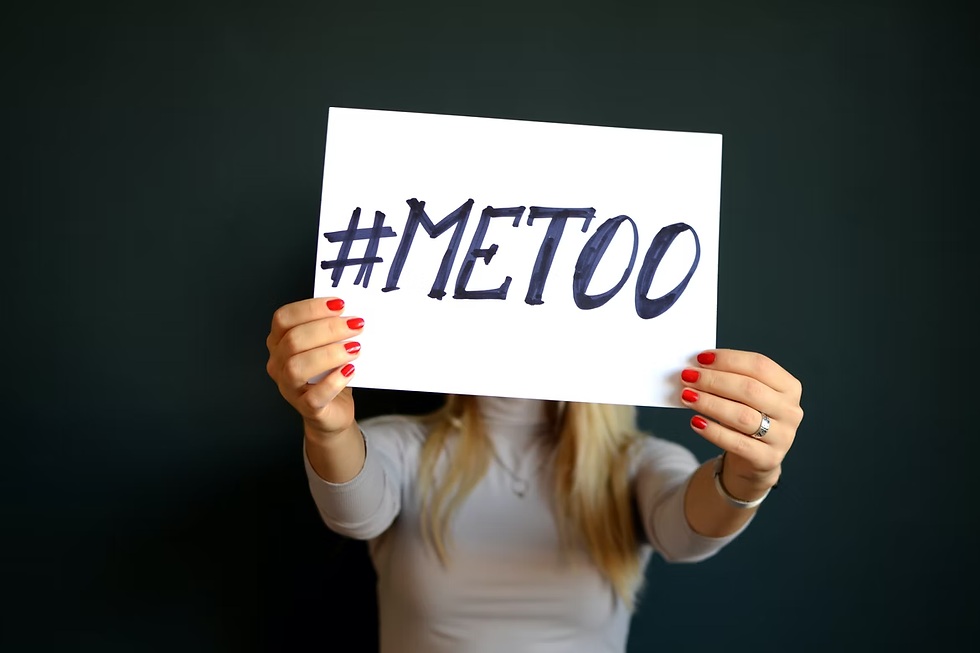New Publication: Discourses of men and masculinity in #MeToo commentaries
- Andrea Waling
- May 30, 2022
- 4 min read
We are very excited to announce the publication of the third output from the Men, Sex and Intimacy project in the Journal of Men's Studies.
“Inoculate boys against toxic masculinity”: Exploring discourses of men and masculinity in #MeToo commentaries" looks carefully at what representations are available to men in #MeToo commentaries.
CONTENT WARNING: Discussions of sexual violence.

Image © Unplash @mihaisurdu. Image of a white woman with long blond hair, red nails, taupe turtle neck and a silver ring on her left ring finger. She holds a #MeToo sign in her hands covering her face, standing against a black background.
What part of the project does it address?
This paper addresses research aim of documenting public discourses concerning consent, men, and #MeToo in the Men, Sex, and Intimacy study.
What is the paper about?
This paper is a partner to "Sex and sexual communication in #MeToo commentaries." Drawing from feminist critical discourse analysis framework, and the same dataset of over 163 traditional news, online magazine, and social news articles collected between October 2017 and June 2020, it explores how the objects of 'men' 'boys' and 'masculinity' are positioned in discussions about the impacts of #MeToo on gender equality and gendered violence prevention. The exploratory findings of this work note several tensions and contradictions highlighting an overall lack of coherency and agreement regarding men’s engagements with, and roles in addressing the aims of #MeToo. Such tensions and contradictions reflect emerging concerns about how best to develop and support gendered violence prevention initiatives to engage men.
What did you find?
The findings of this analysis noted several discourses that work to position men, boys and masculinity in broader #MeToo debates.
One such discourse is that of men and boys as victims of masculinity, which has received increasing attention from several researchers. Such a discourse notes that men need some health intervention that will 'cure' them of their toxic masculinity, and encourage them to seek a healthier version:
'middle school could be an ideal time to inoculate boys against toxic masculinity'
'revolution in the masculine is required, one which calls us to return to a healthy masculinity’
Similar to findings concerning 'good' and 'bad' sex, notions about inherently 'good' and 'bad' men and boys are also apparent, and it is these inherent qualities that will determine whether such men and boys will engage in sexual violence.
‘decent and respectful man has little to fear…good men have nothing to worry about’
Notions of 'bad' men are designated through mythologising and dehumanising language, such as 'pigs,' 'monsters,' and 'cretin' among others. The use of this language discursively produces a mythical ‘Other’ figure, thereby guising the reality that average, everyday men engage in these practices.
Some suggest that men are awakened or in the process of awakening, and many articles seek to document this process under the notion that men were just unaware of the traumas women face:
I was horrified to hear that in the northern NSW town where my former wife and I raised our two daughters during the first decade of the noughties [2000s], the rape and abuse of teenage girls was purportedly not uncommon.
Yet underpinning this process is a disingenuine attempt at being 'woke', that is, using wokeness as a kind of social brand. This is achieved as some articles highlight men's full awareness of their power and capacity to harm women:
‘I stared at her breasts until she stopped yelling at me, adjusted the cardigan she was wearing, and walked away’.
Discourses of Boys and men as inherently 'lost' and needing to be found were also prominent. Some articles position men as incapable of engaging in practices of transformation without additional help and support:
‘they can become angry and lost because they’re still operating from boy psychology’
Lastly, articles debate as to whether men should be 'protectors' who reproduce problematic gender inequalities, or if they remain disingenuous heroes, leading to tensions and uncertainties about what men should do, or how they should respond to #MeToo:
So it’s time for us men to step up and do more. Our society historically expects and encourages men to hold positions of power, so for better or worse, it’s our responsibility to push for cultural and institutional changes that protect and empower women and girls
it’s hard to see how using social media to ask the world to bear witness to your [men’s] generalised confession to coercion, or even, in some cases, to the crime of rape, does anything but trivialise and compound the damage done.
I conclude this piece with an open-ended question, where to from here? In this case, I see the findings of this work leading to more important questions for future research and practice development regarding men and gendered violence prevention.
Where can I read it?
This paper is available in The Journal of Men's Studies! Or please feel free to get in touch and we can send you a copy!
Citation
Waling, A. (2022). ‘Inoculate Boys Against Toxic Masculinity’: Exploring Discourses of Men and Masculinity in #Metoo Commentaries. The Journal of Men’s Studies. https://doi.org/10.1177/10608265221092044.

Comments